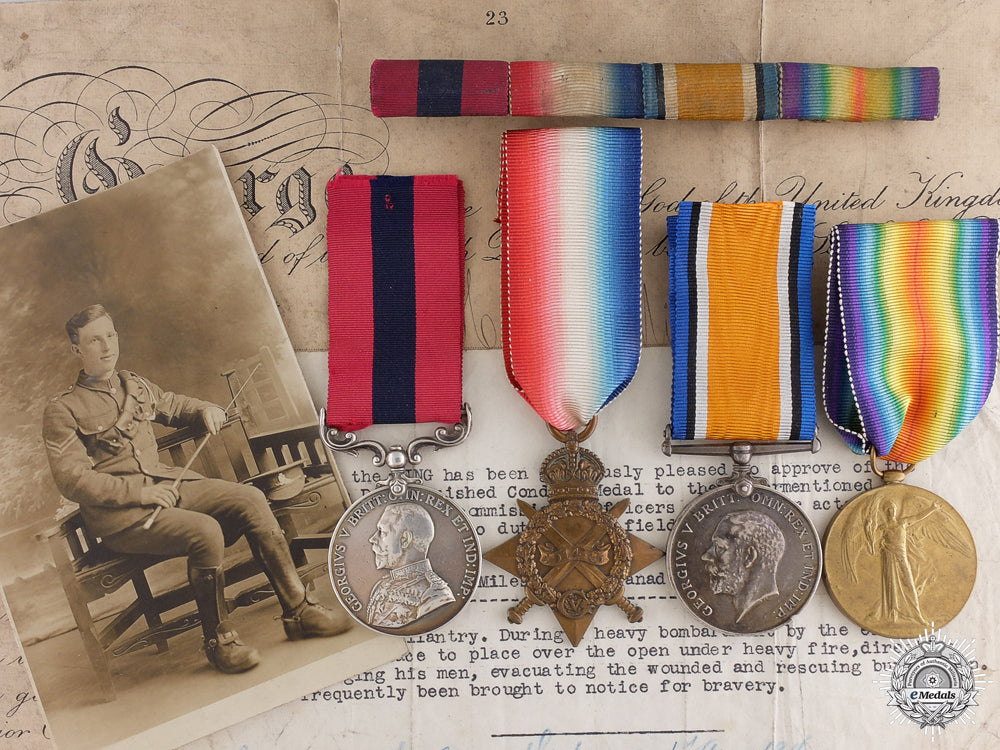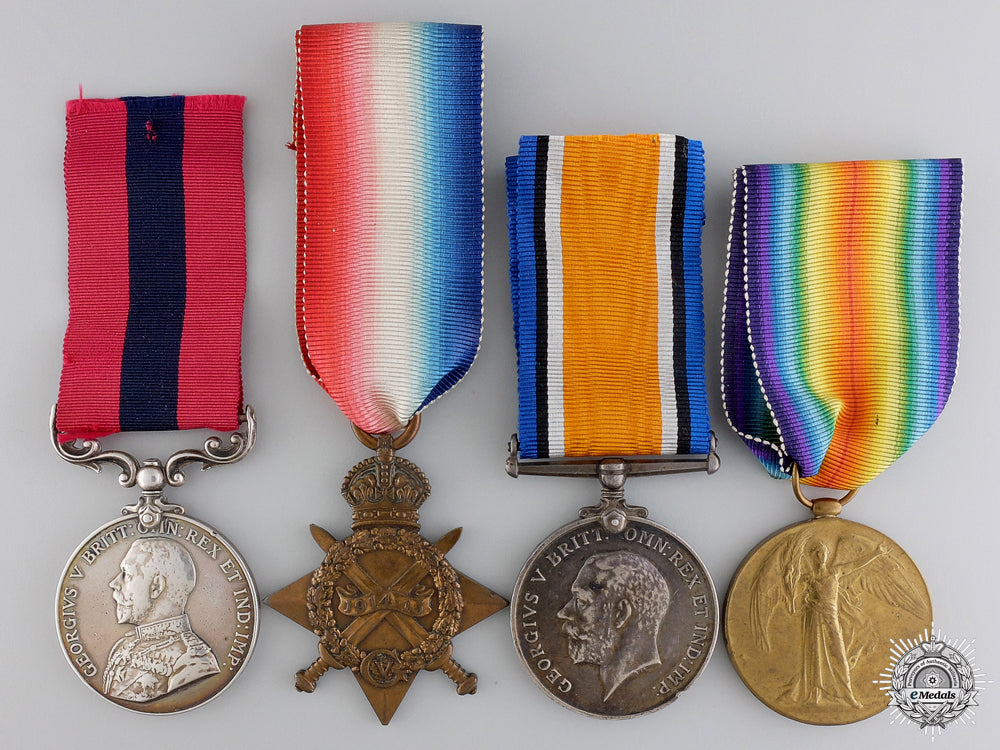Description
Distinguished Conduct Medal Group to Brothers Henry & George Miles; Lieutenant Henry Miles, Royal Field Artillery: Distinguished Conduct Medal, George V (33300 Cpl H. MILES. 5C. RES: BDE: R.F.A.); 1914-15 Star (33300 CPL. H. MILES R.F.A.); British War Medal (2. LIEUT. H. MILES); and Victory Medal (2. LIEUT. H. MILES). Naming is officially impressed. Un-mounted, dark patina on the BWM, edge nicks, light contact, near extremely fine. Accompanied by their original Ribbon Bar (original lightly soiled ribbons, 12.3 mm x 135 mm, with swing bar pinback), a Postcard of Henry Miles in his Royal Field Artillery Uniform (obverse with a sepia-toned photograph, unaddressed backer, 82 mm x 131 mm), original Appointment Document to the Special Reserve of Officers (dated November 7, 1917, 304 mm x 405 mm, with fold marks, soiled) and a CD containing forty-eight pages with copies of his Index Cards, Attestation Paper, Service Records, Medical Records and Discharge Certificates. Also included is his brother's, Lieutenant Charles Miles, 48th Infantry Battalion, original Distinguished Conduct Medal award notification citation, as it appeared in the Supplement to the London Gazette 29637 of Friday, June 23, 1916.
Footnote: Henry Miles was born on May 4, 1894 in St. Mary's, Chesterfield, Derbyshire, England, the son of George Miles and Fanny Miles of Chesterfield. He was educated at Hipper Street School in Chesterfield and was described by the Archdeacon of Chesterfield as the "son of well-to-do, highly respected people" and that he had "always been a leader from childhood." Henry Miles signed his Attestation Paper with the Royal Regiment of Artillery (Royal Horse & Royal Field Artillery) (33300) on August 29, 1914 at Chesterfield, at the age of 20, stating that he had no previous military service, that he was not married and that his trade was that of (Engineering) Clerk. He was posted as a Gunner with the 166th Battery, Royal Field Artillery on September 5, 1914. He was admonished on October 27, 1914, for being absent from 6:00 pm on October 26th to 12:10 am on October 27th at Aldershot, followed by a posting in the new year to 'D' Battery, 32nd Brigade on January 18, 1915. It was here that he was promoted to Bombardier on February 6, 1915 and to Corporal on March 18, 1915. Two months after his second promotion, he entered the French theatre for the first time, embarking Southampton on May 12, 1915, disembarking in Le Havre the next day. He was wounded in action, suffering a gun shot wound to his left leg, on September 25, 1915 and invalided to England aboard the Hospital Ship St. George on October 2nd. Upon arrival, he was transferred to the 5th Reserve Brigade RFA on October 3rd, followed by his admission to the Royal Infirmary at Edinburgh, from October 3rd to December 24th. It was noted by the physician that the "wound (was) received while (the) patient was telephoning" and that it was a "deep septic wound just above knee joint". It was for actions the day that he was wounded, that Corporal Henry Miles, 5C Reserve Brigade RFA (formerly 'D' Battery, 52nd Brigade), was awarded the Distinguished Conduct Medal, as mentioned in the Fourth Supplement to the London Gazette 29438 of Tuesday, January 11, 1916, on Friday, January 14, 1916, page 606: "For conspicuous gallantry, Corporal Miles was in charge of the telephonists, and he continued to work his instrument, although severely wounded in the leg, and when sent back to the dressing station, he carried out, with great bravery and determination, repairs to the wire under heavy fire." He was posted to No. 16 D.W. Artillery on January 15, 1916, to No. 5 Depot RFA at Athlone on September 15, 1916 and at Curragh Camp on March 23, 1917. Henry Miles was accepted for admission to No. 1 Royal Artillery Officer Cadet School at St. John's Wood, N.W. on June 7, 1917, receiving a commission and appointed to the Special Reserve of Officers on November 3, 1917. He returned to the French theatre a second time, disembarking at Boulogne on January 25, 1918 and placed with No. 2 Divisional Ammunition Column on the 31st. He briefly returned to the United Kingdom on September 25, 1918, before re-entering France on a third occasion. 2nd Lieutenant Henry Miles suffered an injury to his left knee, while playing right back in a football (soccer) match, for No. 3 Section team of the 20th Divisional Ammunition Column, against a team composed of players from 'A' Battery, 91st Brigade RFA, at Warlincourt, Saulty, Pas-de-Calais, France, on January 8, 1919. The official report states that "This officer was playing in an organized game of football for the 20th Div. R.A. League. He made a run for the ball, and kicked, and then felt his knee give way. He was carried from the field and the doctor was called." The incident was ruled an "accident in a properly constituted game of football and no one was to blame.", with many eyewitness reports lending support, to confirm that it was an accident. He was subsequently sent to Le Havre for invaliding to England on January 22nd, arriving in Southampton the next day. It was noted here that he had an "internal derangement of the knee" and was "supplied with an Elastic Knee Cap at the Government's expense" on March 19th. By the summer and with hostilities having ceased, he was posted to 4/A Reserve Brigade RFA at Woolwich on June 6, 1919 and demobilized at No. 1 Dispersal Unit in Ripon, on June 16th. For his First World War service, Lieutenant Henry Miles was awarded the 1914-15 Star, the British War Medal and the Victory Medal. He relinquished his commission in the Special Reserve of Officers on April 1, 1920, retaining the rank of Lieutenant, as mentioned in the Third Supplement to the London Gazette 32136 of Tuesday, November 23, 1920, on Wednesday, November 24, 1920, page 11579. His older brother, Charles Miles was born on March 24, 1882 in Chesterfield, Derbyshire, England. Charles fought with the British forces during the South African (Boer) War. He later immigrated to Canada and was a resident of Edmonton, Alberta, when he signed his Attestation Paper with the 49th Infantry Battalion (432037) on January 4, 1915 at Edmonton, at the age of 32, naming his next-of-kin as his wife, Mabel Miles of Edmonton, stating that he was Married and that his trade was that of Steamfitter. The Battalion was raised in Edmonton, Alberta under the authority of G.O. 86, July 1, 1915. The mobilization headquarters was also at Edmonton. The Battalion sailed June 4, 1915 with a strength of 36 officers and 996 other ranks under the command of Lieutenant-Colonel W.A. Greisbach. The Battalion served in France and Belgium with the 7th Infantry Brigade, 3rd Canadian Division. Company Sergeant-Major Charles Miles was awarded a Distinguished Conduct Medal, as mentioned in the Supplement to the London Gazette 29637 of Friday, June 23, 1916, on Saturday, June 24, 1916, page 6303, his citation reading "For conspicuous gallantry. During a heavy bombardment by the enemy he moved from place to place over the open under heavy fire, directing and encouraging his men, evacuating the wounded and rescuing buried men. He has frequently been brought to notice for bravery." He was wounded at the Battle of Cambrai in late 1917 and was invalided to England. While hospitalized, Company Sergeant-Major Charles Miles, DCM, Alberta Regiment (49th Infantry Battalion) was "to be Temporary Lieutenant", as mentioned in the Supplement to the London Gazette 30861 of Friday, August 23, 1918, page 9894. He eventually died from his wounds eleven months after the battle, on October 26, 1918, at the age of 36. He is buried at Chesterfield (Spital) Cemetery, Chesterfield, Derbyshire, Grave Reference: Old. 3191. and is commemorated on page 470 of the First World War Book of Remembrance. Although the whereabouts of his DCM and First World War trio remains unknown, the brothers are both confirmed as DCM winners.






































